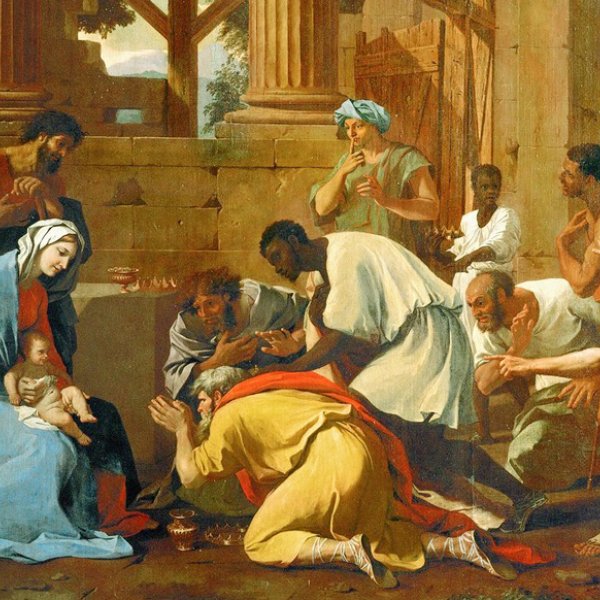Christmas Pilgrimage

Graupner - Das Volk so im Finstern wandelt
Friday, December 13, Emmanuel Church, Boston
Sunday, December 15, First Unitarian Church, Worcester
Mache dich auf, werde licht Augustin Pfleger (ca.1635-ca.1690)
Pastorale per la notte di Natale Johann David Heinichen (1683-1729)
Der mit Sunden beleidigte Heiland, TWV 1-306 Georg Philipp Telemann (1681-1767)
Pifa (from Messiah) George Frideric Handel (1685-1759)
Intermission
Concerto Pastorale Johann Christoph Pez (1664-1716)
Pastorale (Adagio) • Aria (Presto) • Aria (Grave)
Aria. Pastorale (Presto) – Adagio
Minuet • Passacaglia • Aria (Presto)
Das Volk so im Finstern wandelt, GWV 1111/29 Christoph Graupner (1683-1760)
Jessica Petrus, soprano; Sophie Michaux, mezzo-soprano
Jason McStoots, tenor; David McFerrin, baritone
Suzanne Stumpf and Rachel Carpentier, traversi; Sarah Darling and Susannah Foster, violins
Marcia Cassidy, viola; Daniel Ryan, cello; Michael Bahmann, harpsichord
Program Notes
The selection of works for this program draws its inspiration from the seasons of Christmas and Epiphany. Our featured vocal compositions are German Baroque works that tell stories of the birth and infancy of Christ, and the journeys of the shepherds and Magi as guided by the illuminating light of the star. Our chosen instrumental pieces are inspired by the shepherds in the Christmas story—each is a unique Pastorale.
Mache dich auf, werde Licht is a sacred concerto for Epiphany that is part of a cycle of 72 such works Augustin Pfleger composed for the church year. Of Bohemian birth, Pfleger spent his career at the courts of Schlackenwerth (now Karlovy Vary in the Czech Republic), and Gottorf and Mecklinberg in northern Germany. This piece, like many in the cycle, assigns characters to each of the vocal parts. They are: Soprano 1 - Eclesia judaica; Soprano 2 - Jesulus; Tenor - Locus magorum; Bass - Deus per prophetas. Each character participates in the lively exchange of exhortation and revelation to the Gentiles about the arrival of the Savior, culminating in a chorus of praise.
The prolific and seemingly tireless Georg Philipp Telemann composed at least twenty annual cycles of cantatas totaling over 1,700 for the cities of Eisenach, Frankfurt, and Hamburg. Due to Telemann’s talent and industry as a publisher, his cantatas received wide circulation throughout Germany. The Telemann cantata presented on this program was written for the feast of the Circumcision (January 1). The text of this cantata centers around Jesus’ circumcision as a precursor to the suffering he would endure for the redemption of mankind. The Savior’s “sea of grace” provides the believer with a “safe shelter,” a joyful sentiment reflected in Telemann’s flowing, yet exuberant figuration in the final aria.
Christoph Graupner was another prolific composer of cantatas. His early musical training included studies at the Thomasschule in Leipzig under Johann Schelle and Johann Kuhnau. He later composed for and performed at the Hamburg opera and in 1712 become Kapellmeister at the court of Darmstadt. It was there that he wrote the majority of his works, encompassing more than 1,000 cantatas and hundreds of instrumental compositions. His cantata Das Volk so im Finstern wandelt was written for Epiphany, 1729, and is in all likelihood receiving its modern day premiere on these concerts. The work is filled with vivid text painting. Its opening chorus depicts “the people wandering” with pulsing notes in the strings that create a mysterious texture and vocal melismas set in counterpoint. This is sharply contrasted with the majestic rhythms used for the text “see a great light.” In the tenor and bass duet, a short and sharp repeating rhythmic figure in the violins and voices evokes the flickering of a star. The gently scampering motifs in the solo flute in the alto aria embody the call to “hurry” in the text. The work ends with a chorale soaring over energetic and busy orchestral lines that portray the message of faithful toil and dedication.
For centuries, Christmas music has become associated with the pastoral style. In both sacred and secular Christmas works, the presence of shepherds in the nativity story has inspired the inclusion of musical motifs such as lilting melodies in triple meter spun out over droning basses in imitation of shepherd instruments such as the shawm and bagpipe. The three pastorales presented on this program are in this tradition.
The pastorales by Heinichen and Handel are single-movement works that make use of the classic dotted rhythm of the Italianate alla siciliana. Johann David Heinichen was a composer at the Dresden court who wrote many works for the large, virtuoso orchestra there. Heinichen spent time in Rome where he met Vivaldi and other leading composers in the region, and his single-movement Pastorale for Christmas Night reveals an Italian influence. The familiar “Pifa” from Handel’s Messiah is used in that oratorio to function as a bridge between prophecy and fulfillment, magically setting the scene for the Angel’s appearance to the shepherds announcing the birth of Jesus.
The Concerto Pastorale by Johann Christoph Pez is a large instrumental suite that presents a variety of movement types, beginning with and incorporating pastorales. Although Pez spent most of his career as a composer of church music at the court in Munich, he composed many well-regarded instrumental works, some finding publication in England and Holland. This concerto reveals Pez’s charming sense of melody, a skill that inspired Telemann to include mention of his “flattering sonatas” in a poem he penned about noteworthy German musicians.
—Suzanne Stumpf and Daniel Ryan
